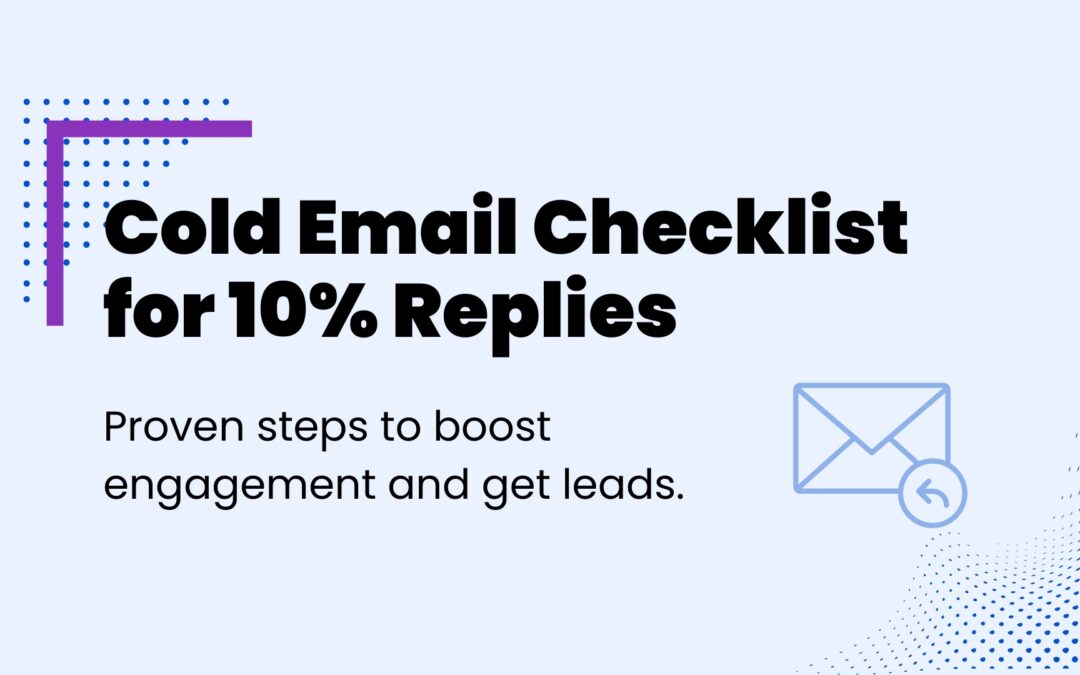Cold emailing, when done right, can be a powerful tool for generating leads and growing your business. However, the reality is that most cold email campaigns fall flat. The key to success lies in a meticulously planned and executed strategy. This checklist outlines the basic requirements of each cold email campaign that often go overlooked.
Before You Hit Send: Infrastructure Readiness
- Separate Domain: Avoid using your primary company domain for email campaigns. 70% of senders make this mistake! Dedicate a secondary domain for every 1,000 prospects you target per month.
- Multiple Email IDs: Within each dedicated domain, create 5 email addresses. This helps distribute sending volume and avoid spam filters. Each email ID can target approximately of 200 – 250 prospects per month.
Building Your Prospect List
- Know Your Ideal Customer Profile (ICP): Sharply define your ideal customer. Consider creating multiple ICP profiles to experiment and discover the most profitable audiences.
- Identify Pain Points: Clearly understand the specific problems your ICP faces. Use pain point discovery techniques if needed. You can have multiple pain points per ICP. The same can be setup as experiments.
- Verified Emails: Secure at least 1,000 verified email addresses per month. Tools like Clay.com or Apollo.io can help. Unverified emails lead to high bounce rates, which damage your email deliverability.
Securing Your Domain
Based on where you purchased your domain, there are a few one time configurations that are needed for a newly purchased domain. You can understand how to set these up by following the guides in the GetReplies platform.
- Setup MX (Mail Exchange) Records: MX records are DNS settings that direct email to a mail server, ensuring that emails reach their intended destination.
- Setup SPF (Sender Policy Framework) Records: SPF records help to verify that incoming mail from a domain comes from a host authorized by that domain’s administrators, reducing the chance of email spoofing.
- DKIM (DomainKeys Identified Mail): DKIM provides a way to validate a domain name identity that is associated with a message through cryptographic authentication, enhancing email security and helping to prevent email spoofing.
- DMARC (Domain-based Message Authentication, Reporting, and Conformance): DMARC is an email authentication, policy, and reporting protocol that helps domain owners protect their domain from unauthorized use, commonly known as email spoofing. It builds on SPF and DKIM protocols to improve and monitor the protection of the domain from fraudulent email.
- Domain Forwarding: Domain forwarding allows you to redirect one domain to another, enabling users who type the original URL in their browser to be automatically directed to a different web address. This is useful for ensuring that secondary domains point to the primary domain in case any bots or users actually hit the secondary domain.
Experts at GetReplies can help you setup these configurations.
Ensuring Email Delivery
- Warming Up Email IDs: New email addresses need a warm-up period of 4-6 weeks to gradually increase sending volume. This reduces the risk of emails being flagged as spam. Regularly rotate your email IDs to maintain a healthy sending reputation.
- IMAP and SMTP Enabled: These protocols are essential for sending and receiving emails. Ensure they are enabled for your domain/ email ID. To understand how to enable them, you can follow the guide in the GetReplies platform: Fixing mailbox error.
Crafting Your Email Sequence
- Multi-Touch Approach: A sequence of 7-9 touch points spread over 15 days typically generates better reply rates. You get a definitive Yes or No from most prospects.
- Catchy Subject Lines: Use subject lines that resonate with your specific ICP. Find inspiration from this article titled Top 10 Email Subject Lines for Better Replies
- Personalization is Key: Personalized emails see higher open and reply rates. While manually personalizing thousands of emails can be time-consuming, tools like GetReplies can automate this process. An SDR could take an entire day to write personal emails for 10 prospects. With GetReplies you can write personal emails for 1000 prospects in 4 minutes.
- Mobile-Friendly Design: Most people check emails on their phones. Ensure your emails are structured clearly for easy mobile readability. Paragraph formatting with a maximum of 02 sentences per paragraph ensure good mobile readability. Each sentence should not be more than 14 words.
- Clear Call to Action (CTA): Guide recipients towards a specific action you want them to take. However, consider delaying a direct CTA in the initial emails to encourage email deliverability and higher chance of a reply. CTAs do end up distracting prospects some times.
- Unsubscribe Option: Provide a clear way for recipients to unsubscribe. Encourage them to reply with specific keywords rather than using a hidden unsubscribe link. The replies add up to email delivery score.
Execution and Scaling
- Planned Sending: Limit each email ID to 200 prospects per month (roughly 100 emails per day).
- Gradual Scaling: Increase your target prospects by 20% every 15 days. However, don’t exceed 2,000 prospects per domain.
- Email Spacing: Maintain a minimum 3-minute gap between sending emails from the same address. If you use GetReplies, we keep this anywhere between 3 to 9 minutes between campaigns. Avoid sending multiple emails simultaneously.
Measuring Success
- Bounce Rate: Aim to keep a bounce rate below 2%. If higher, either re-verify your email list using Clay.com or re-warm your email IDs. Some specialized platforms include Zerobounce, Neverbounce, Clearout.
- Reply Rate: GetReplies users can expect a reply rate of 2-10%. If lower, revisit your ICP definition or analyze how well your prospect list aligns with your ideal customers.
- Unsubscribe Rate: Keep unsubscribe rates below 5%. Similar to reply rates, a high unsubscribe rate indicates potential issues with your ICP definition or prospect list.
- Open Rates and Click Rates: These metrics can be unreliable due to tracking limitations. Read this article by GetReplies to understand why: Open Rates Matter? Lol!
Conclusion:
This checklist equips you with the foundational elements for successful cold email outreach. For further guidance and support, contact GetReplies. We offer a comprehensive platform for managing cold email campaigns, as well as lead generation services. Let us help you achieve consistent 2-10% reply rates and start generating leads from your cold email efforts!


